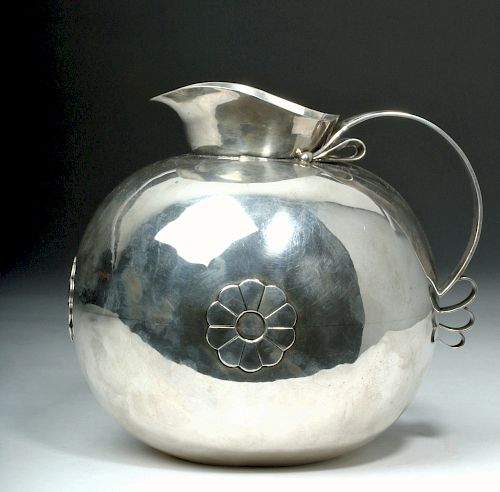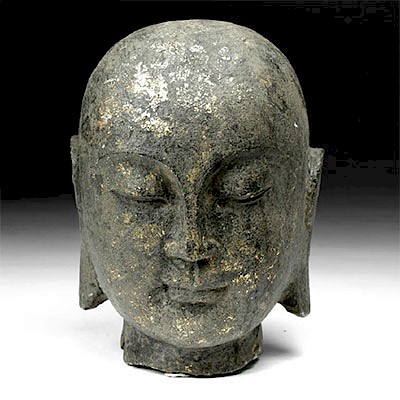1940s Spratling Mexican Sterling Silver Water Pitcher
Lot 228d
About Seller
Artemis Fine Arts
686 S Taylor Ave, Ste 106
Louisville, CO 80027
United States
Selling antiquities, ancient and ethnographic art online since 1993, Artemis Gallery specializes in Classical Antiquities (Egyptian, Greek, Roman, Near Eastern), Asian, Pre-Columbian, African / Tribal / Oceanographic art. Our extensive inventory includes pottery, stone, metal, wood, glass and textil...Read more
Estimate:
$11,000 - $16,500
Absentee vs Live bid
Two ways to bid:
- Leave a max absentee bid and the platform will bid on your behalf up to your maximum bid during the live auction.
- Bid live during the auction and your bids will be submitted real-time to the auctioneer.
Bid Increments
| Price | Bid Increment |
|---|---|
| $0 | $25 |
| $300 | $50 |
| $1,000 | $100 |
| $2,000 | $250 |
| $5,000 | $500 |
| $10,000 | $1,000 |
| $20,000 | $2,500 |
| $50,000 | $5,000 |
| $100,000 | $10,000 |
| $200,000 | $20,000 |
About Auction
By Artemis Fine Arts
Nov 29, 2018
Set Reminder
2018-11-29 10:00:00
2018-11-29 10:00:00
America/New_York
Bidsquare
Bidsquare : Holiday Glitz - Ancient / Ethnographic Art
https://www.bidsquare.com/auctions/artemis-gallery/holiday-glitz---ancient-ethnographic-art-3672
What to give this holiday season? Think silver, gold, bronze, shiny, glittery, wearable, festive. We ship worldwide and handle all shipping in-house for your convenience. This is one sale you don't want to miss! Artemis Fine Arts info@artemisfinearts.com
What to give this holiday season? Think silver, gold, bronze, shiny, glittery, wearable, festive. We ship worldwide and handle all shipping in-house for your convenience. This is one sale you don't want to miss! Artemis Fine Arts info@artemisfinearts.com
- Lot Description
William Spratling (American, 1900-1967), Mexico, ca. 1940 to 1946 CE. A stunning sterling silver water pitcher created by William Spratling, the American expatriate artist, author, and entrepreneur best known for his work as a silversmith and designer who revitalized Taxco, Mexico's silver industry in the early to mid 20th century. Note one of Spratling's hallmarks dating to the 1940s and reading "Spratling Made in Mexico" around a stylized bird with STERLING printed below, graces the underside of the base. The pouring vessel presents a stylish design comprised of a spherical body adorned with a 10-petaled open flower blossom on each side, an elegant pouring spout, and an arched handle, both the rear end of the spout and the base of handle are adorned with looped, ribbon-like motifs. Wonderful hand hammering impressions are visible on the interior. Size: 8" W at widest point x 7.5" H (20.3 cm x 19 cm) Weight: 1074.5 grams
William Spratling made his initial visit to Mexico in 1926, and returned each summer for the next several years. Finally, in 1929, Spratling actually moved to Mexico to be an expatriate, becoming an active member of the vibrant artistic circles of Mexico. Spratling promoted the art of none other than Diego Rivera to New York galleries which led to Rivera's participation in the first exhibition of Mexican visual culture held in the United States, funded by the Carnegie Institute, that opened at the Metropolitan Museum of Art in New York. Not only did Spratling assist in curating the exhibition, but he also lent a number of his own pieces. During this same time period, Spratling was working on drawings for the expanding Morrow (US Ambassador to Mexico Dwight Morrow and his wife, the poet Elizabeth Cutter Morrow) home in Cuernavaca. Many of these drawings were included in the book written by Elizabeth Morrow entitled, "Casa Mañana" (Knopf, 1930). It was Ambassador Morrow who suggested that Spratling explore developing the silver industry in Taxco.
Trying to find a way to support himself as an expatriate artist, Spratling took notice of the Taxco's silver-mining history and opened a workshop called the Taller de las Delicias, which translates to "Factory of Delights". Years later, he would write: “Nineteen-thirty-one was a notable year in modern Mexican silversmithing. A young silversmith from Iguala named Artemio Navarrete went to Taxco to work for a small silver shop, founded with the germ of an idea, where Artemio, as a nucleus, began to form silversmiths. The present writer, encouraged by his friends Moises Saenz, Dwight Morrow and Diego Rivera, had set up that little shop called ‘Las Delicias.’”
Penny Chittim Morrill, Ph.D., who co-authored :Mexican Silver: 20th Century Hand-wrought Jewelry & Silver" with art dealer Carole Berk is the primary authority on Spratling’s work. Morrill was the guest curator for the 2002 traveling exhibition entitled, "William Spratling and the Mexican Silver Renaissance: Maestros de Plata," organized by the San Diego Museum of Art. In her catalogue essay, Morrill stated, “In establishing silver as an artistic medium, what Spratling achieved was a delicate balance, a synthesis of abstract tendencies in the existent folk art tradition and in contemporary fine art, resulting in a visualization of concepts and ideas. As importantly, the Taller de las Delicias, became the paradigm for other silver designers to follow. Las Delicias was a community in which imagination and innovation were fostered and encouraged as the men learned the art of silversmithing while producing for profit. In the hierarchy of the workshop, these silversmiths advanced according to their ability, enthusiasm, and technical expertise.”
Provenance: ex private Santa Fe, New Mexico, USA collection
All items legal to buy/sell under U.S. Statute covering cultural patrimony Code 2600, CHAPTER 14, and are guaranteed to be as described or your money back.
A Certificate of Authenticity will accompany all winning bids.
We ship worldwide and handle all shipping in-house for your convenience.
#125694Minor tarnish. Wonderful hand hammering marks visible on interior. Hallmark is a tad worn, but still decipherable.Condition
- Shipping Info
-
All shipping is handled in-house for your convenience. Your invoice from Artemis Gallery will include shipping calculation instructions. If in doubt, please inquire BEFORE bidding for estimated shipping costs for individual items.
-
- Buyer's Premium



 EUR
EUR CAD
CAD AUD
AUD GBP
GBP MXN
MXN HKD
HKD CNY
CNY MYR
MYR SEK
SEK SGD
SGD CHF
CHF THB
THB


















